The Asian section of our journey had a clear beginning and now a clear end. We started in Hong Kong to get visas for China. We spent Christmas in Chengdu, China, with friends, then cycled south. We rode through Vietnam, Laos, Cambodia, Thailand, Malaysia and finally, into Singapore. We spent four and a half months covering just over 6,000 kilometers. While each country was unique, there are some overarching similarities among Asian nations. Characteristics that we would label “Asian flair” as we went along.
We actually began compiling this list as our time in Asia grew small. We’ve been meaning to put it on the blog for a while. But honestly, it’s not so bad that it’s late, as we appreciate these “uniquely Asian” characteristics even more now that we’re cycling in our homeland. So here they are, the good with the bad:
The Squat Toilet
We usually call it the squatty potty. This one won’t be missed.
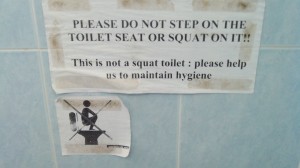
This sign… only found in places where the squat toilet is a part of the culture. This was in one of our nicer guesthouses.
Rice in Every Meal
One thing you can say for Asians: they know how to cook rice. We’ve had rice noodles, rice paper, fried rice, rice porridge, rice desserts, rice beer… you name it—they can make it with rice. This staple food can be found in many shapes and forms In Asia, but of course, also comes frequently in its most simple form: white rice served with your meal.
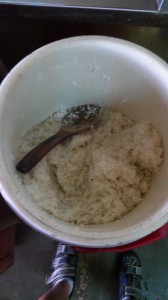
For lunch, we would get giant servings of rice scooped out of this kind of large cooler–about a five-gallon thermos.
The Asian Kitchen
We’ve realized how much “stuff” we have in American kitchens. After we got married, our kitchen cabinets were chock full with awesome wedding gifts. For gadgets, we have a stand mixer, a crock pot, a food processor, a blender. We have baking dishes and cookie sheets, pots and pans of all sizes, cutting boards, strainers, salad bowls, utensils… and more.
This would be absolutely excessive in Asia. We have decided that you can reduce a true Asian kitchen to four critical items:
1—The cleaver.
Asians need no other blade. The cleaver is used to chop any and everything, from tiny chili peppers to whole ducks. They cleaver it up on their wooden chopping block, then toss it in…
2—The wok
It necessarily sits atop a jet blaster of a one burner gas stove on a stand and can fry anything. That anything, is of course, served with the side dish of rice from…
3–The rice cooker
Duh… remember, rice is in every meal! We’ve never seen rice cookers as big as the ones in Asia! And of course, all of this comes with a bowl of soup from…
4—The huge pot
We usually opted out of the soup. Who wants soup for lunch in 35-degree (95 Fahrenheit) weather?
The Drink “To Go”
This can actually be found in most of the developing world… but most commonly is found in Asia. Order your drink “for take away,” and instead of giving you a styrofoam or paper cup, it gets served up in a plastic bag! Hot drinks and cold drinks alike—they pour it in, throw in a straw and hand it to you like it’s the most normal thing in the world. And in Asia, I suppose it is.
On the drink note, we will also not be drinking from straws when we get a canned drink anymore. In most of Asia, it’s not recommended to drink straight from the can because it might have been contaminated.
Frequent “hotel” rooms
Hotel is used quite liberally here as we typically seek out the cheapest room in town. Very rarely would the places we stay be considered a hotel by Western standards. The search for the lowest bidder is sometimes a long one and consists of asking if there are rooms available, then walking (normally up several flights of stairs) to the room and evaluating it. While inside, we assess the following:
1. The smell – moldy? stale? general funk?
2. The bed – is it tiny? does it look like it is actually flat?
3. The toilet – squatty style (see above)? manual flush?
4. The sink – suitable for clothes washing? Does it have a drain?
This just gives you a general idea… the rooms were often rough, but indeed, it was a room indoors for the night, and the price was usually low, making it worth it for us.
The “moto”
We’ve realized there is a distinguishable difference between a motorcycle and a “moto.” A motorcycle is a vehicle you find in Europe or in the US, with a large motor capable of high acceleration and speed. A moto is typically a smaller two-wheeled vehicle, more of a glorified bicycle with an engine and no pedals (think scooter rentals at the beach). The moto is the transportation of choice in many Asian countries. And there’s almost no limit to what they’ll load up on these things–from a few mattresses to giant boxes to the whole family–infants included. In fact, on two different occasions in Cambodia we saw the back passenger on a moto carrying his own IV bag.
The market
While shopping at the market can be a fun and cultural experience for many tourists, doing it every day can be a bit tiresome. The sights and smells of the market in tourist areas are not so bad, but in the “in-between” places where we often find ourselves, it can be a different story. It’s usually a large but stuffy building… not necessarily arranged in an intuitive format. Typically we would search out the vegetable and fruit stalls, hoping to make our purchases without needing to pass the unrefrigerated, completely exposed meat or seafood areas.
On the food note… while Asian food was good and typically cheap, we’re not going to miss the constant exposure we had to contamination. Altogether, we had four instances when we had to resort to prescription medication (which conveniently in these countries, was usually available over-the-counter). So we averaged about once per month. That’s kind of high! Food in the US is generally just safer to eat, and we’re thankful to give our digestive tracts a break!
Asia… cycling there was such a contrast to our life on the road back in the States. But we took the good with the bad, and altogether, loved our time there. And while we wouldn’t have minded having a little more, we certainly don’t mind being back in the land of convenience and comfort.

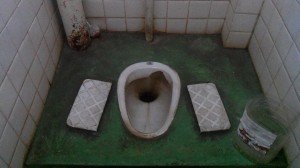
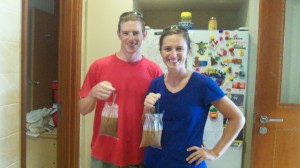
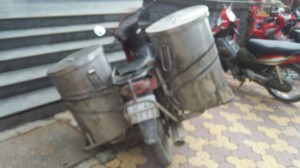
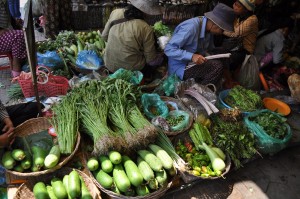
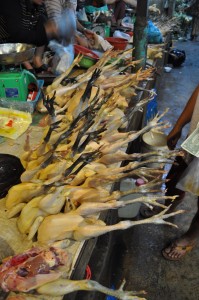
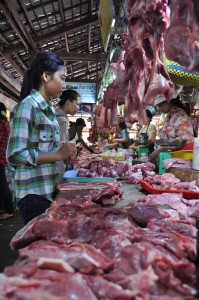
1 comment
Julie C Beasley says:
Jun 29, 2013
Wow.